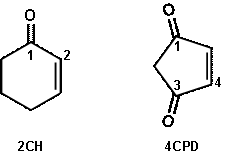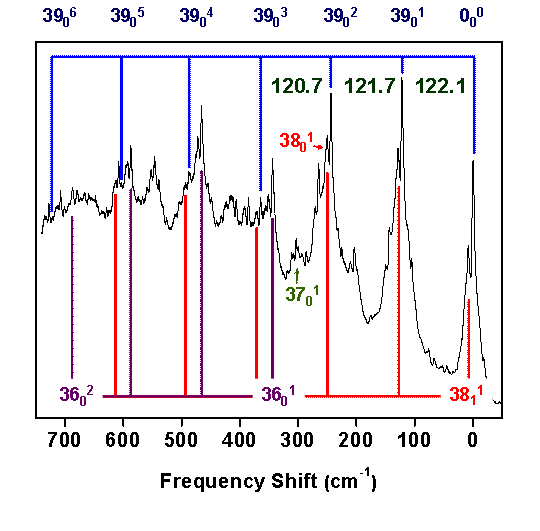
ACS PRF | ACS
All e-Annual Reports

42824-B6
Spectroscopic Studies of Cyclic Enones in Triplet Excited States
The main goal of this grant is to characterize the structure and dynamics of low-lying triplet excited states of monocyclic enones. We use the highly sensitive cavity ringdown (CRD) spectroscopic technique to contend with the spin-forbiddenness of the singlet-triplet transitions originating in the electronic ground state. During year 2 of the grant we focused on the molecules 2-cyclohexen-1-one (2CH) and 4-cyclopenten-1,3-dione (4CPD).

A. CRD Spectroscopy of 2-Cyclohexen-1-one (2CH)
A primary goal of our work on the 2CH molecule is to characterize potential-energy functions for the lowest-frequency ring-bending (or inversion) mode, ν39, in the S1(n,π*) and T2(n,π*) excited states. During year 2 of the PRF grant we made further assignments in the previously reported[1] S1(n,π*) ← S0 CRD spectrum, and thereby determined frequency intervals of the ν39 vibrational mode in the S1 state (see Figure 2). These new results are reported in manuscript submitted in July 2007 to The Journal of Physical Chemistry A. In collaboration with Prof. Jaan Laane (Texas A&M) we determined a one-dimensional effective potential for ν39 in the S1 state by using the assigned frequency intervals (~ 120 cm-1) in the CRD spectrum. These intervals differ from those of the ground state (~ 99 cm-1) and stem from a potential function that has a significantly higher barrier to planarity.
We have also continued our analysis of the CRD spectrum of 2CH in the T2(n,π*) ← S0 absorption band region. This band system is exceedingly weak, with εmax on the order of 0.1 M-1 cm-1. Under the present PRF grant we have increased the signal-to-noise ratio in this spectrum by improving the spatial conditioning of the laser. The T2(n,π*) ← S0 spectrum of 2CH in Figure 3 was presented at the National ACS meeting in March 2007. A notable finding in this work is that the ν39 fundamental frequency drops to 99 cm-1 in the T2(n,π*) excited state, compared to 122 cm-1 in the S1(n,π*) state.
We plan to record a spectrum of a deuterated derivative, 2CH-2,6,6-d3, in order to confirm the vibronic assignments in Figure 3. We recently developed and implemented a protocol for preparing the deuterated derivative.
Figure 2: CRD absorption spectrum of 2CH recorded in a static gas cell at room temperature. The region shown includes the S1(n,π*) ← S0 origin band at 26,081 cm-1, and includes a progression in the ring-inversion mode, ν39, indicated by the blue tie lines. The same progression, shown by the purple tie lines, is attached to the ν36 (ring torsion) fundamental, beginning at 344 cm-1. The ν39 progression is also repeated (red tie lines) as a series of bands attached to the 3811 (ring twist) sequence band. Figure 3: Room-temperature CRD absorption spectrum of 2CH in the T2(n,π*)←S0 region. Key to symbols: ● triplet-state origin or fundamental; ♦ combination band. Blue tie lines indicate progressions in the triplet-state ring-inversion mode; red tie lines indicate progressions in the ground-state. B. CRD Spectroscopy of 4-Cyclopenten-1,3-dione (4CPD) In 2CH, as well as the 2-cyclopenten-1-one (CP) molecule studied previously,[2] we found significant differences when comparing ring vibrational frequencies in the singlet vs. triplet (n,π*) excited states. To investigate whether this is a general property of the conjugated cyclic enones, we recorded the first T1(n,π*) ← S0 CRD absorption spectrum of the 4CPD molecule. The spectrum is shown below along with vibronic assignments. Analysis of combination differences shows that the ν19 (ring pucker) fundamental frequency in the T1(n,π*) and S1(n,π*)[3] states is nearly the same, whereas the ν14 (ring twist) frequency is 20% lower in T1 than in S1. Figure 4: Room-temperature CRD absorption spectrum of 4CPD vapor in the T1(n,π*)←S0 region. The origin band is observed at 20,540 cm-1. C. Construction of a Free-Jet Expansion Chamber In 2007 we published the jet-cooled phosphorescence excitation (PE) spectrum of 2CP,[4] complementing the room-temperature CRD study we had previously reported (Ref. 2). The jet-cooled study was conducted at 

